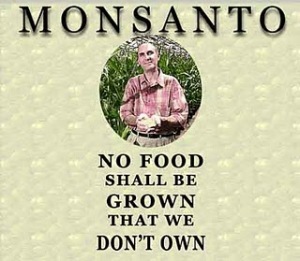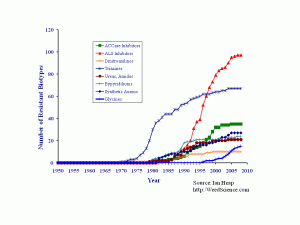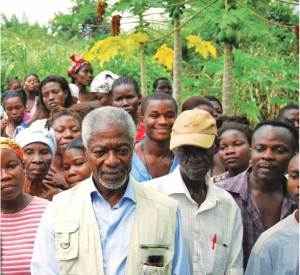Why do you bring your mistakes here?
Kofi Annan has joined with President Obama, Monsanto, AGRA, and the Gates foundation to promote and execute food aid that replaces bags of wheat, rice and corn (agricultural dumping) with bags of pesticides, herbicides, chemical fertilizers and genetically engineered seeds. The end result will be to starve people in Africa and feed corporations in the US and Europe.Under the guise of “sustainability” the [Gates] Foundation has been spearheading a multi-billion dollar effort to transform Africa into a GMO-friendly continent. The public relations flagship for this effort is the Alliance for a Green Revolution in Africa (AGRA), a massive Green Revolution project. Up to now AGRA spokespeople have been slippery, and frankly, contradictory about their stance on GMOs.If you have questions about Monsanto’s agenda, here it is in brief:
…
If you had any doubts about where the Bill and Melinda Gates Foundation is really placing its bets, AGRA Watch’s recent announcement of the Foundation’s investment of $23.1 million in 500,000 shares of Monsanto stock should put them to rest. Genetic engineering: full speed ahead. (Eric Holt-Gimenez)
At a biotech industry conference in January 1999, a representative from Arthur Anderson, LLP explained how they had helped Monsanto design their strategic plan. First, his team asked Monsanto executives what their ideal future looked like in 15 to 20 years. The executives described a world with 100 percent of all commercial seeds genetically modified and patented. Anderson consultants then worked backwards from that goal, and developed the strategy and tactics to achieve it. They presented Monsanto with the steps and procedures needed to obtain a place of industry dominance in a world in which natural seeds were virtually extinct. (Jeffrey M. Smith)

Kofi Annan is Chairman of the Board of Directors for AGRA. He is convening a conference in Ghana in the first week of September. As detailed in this blog, and by others, both AGRA and USAID top positions are filled with people that come from Monsanto and Dupont.
Kofi Annan Calls For United Effort To Accelerate African Green Revolution
African heads of state, industry representatives, the international donor community and farmers will meet in Ghana at the African Green Revolution Forum (AGRF) in the first week of September. Delegates will create an action plan on the acceleration of a Green Revolution in Africa.Samuel Amoako has reported on this as well: Kofi Annan Hosts Forum On Africa’s Food Security in the Ghanaian Times on August 11.
It is worrisome that Kofi Annan is connected with AGRA. Maybe he believes that US mechanized and chemical agriculture work well. Most people in the US do, aside from family farmers who see the effects first hand. I have a good friend who works for the US Dept. of Agriculture and thinks this kind of big agriculture really is the best and that Monsanto is a boon to mankind. We have had several heated discussions. In fact Monsanto is destroying land, causing chemically induced human diseases, creating super weeds, super insect pests, and economic havoc in many parts of the US farming areas, particularly in the midwest and the south. There have been countless protests all over India and Brazil. I’ve read many heartbreaking stories, including this comment from Pearl on this blog:
The farmers of southern Kentucky have been enslaved by Monsanto. The previous generation fell for an ad campaign called “Hi-bred” or “High-Bred”, and the current generation is stuck with fulfilling the contracts their fathers signed. The chemicals that Monsanto has contractually required be applied to those fields have so damaged the soil that the only way to get anything to grow in the fields now is to keep applying more of those blasted chemicals. So even if a person who inherited a contract WANTS to discontinue the agreement with Monsanto when the contract expires, they are unable to do so unless they want to leave the land fallow for many, many, many years. Most farmers cannot afford to do this, as this would mean little to no income for their families for somewhere between 5 to 20 years, depending on how long it would take for the soil to renew itself.I’ve always had enormous respect for Kofi Annan, I do not understand his participation in this and it bothers me a great deal. Even though I admire and respect him there are no free passes with a subject like this.
Genetically modified crops produce less, not more, than conventional crops.
Alexis Baden-Mayer points out in Dupont, Monsanto, and Obama Versus the World’s Family Farmers that AGRA is basing its programs on myth:
Most of the world’s food is not produced on industrial mega-farms. 1.5 billion family farmers produce 75 percent of the world’s food.And as I’ve discussed before, the smaller the farm the greater the yield.
The hunger problem is not caused by low yields. The world has 6 billion people and produces enough food for 9 billion people.
There is an inverse relationship between the size of farms and the amount of crops they produce per hectare. The smaller they are, the greater the yield.The key to true food security is food sovereignty, and the key to food sovereignty lies in who controls the land. The problems of both starvation and obesity stem from injustice in the way farmland and food are distributed. AGRA policies will poison the land and water, destroy local seeds and seed gene pools that provide the true hope for food sustainability. Local agriculture in most parts of the world has developed seeds that are tough and resistant to local pests, weeds, and local environmental dangers such as droughts or floods. AGRA wishes to replace these seeds with ones that need expensive, continuous, and ever expanding chemical coddling. These chemicals will poison the land, the water, and the people.
In some cases, the difference is enormous. A recent study of farming in Turkey, for example, found that farms of less than one hectare are twenty times as productive as farms of over ten hectares(3). Sen’s observation has been tested in India, Pakistan, Nepal, Malaysia, Thailand, Java, the Phillippines, Brazil, Colombia and Paraguay. It appears to hold almost everywhere. (Monbiot)
Additionally the Gates Foundation, Monsanto, and other corporate interests are investing in a doomsday seed bank, in which they will own the world’s agricultural gene pool. They are storing seeds from all over the world. In the event of genetic disaster, they will own the surviving gene pool.
Jonathan Weiner, in The Beak of the Finch describes how chemicals drive the destruction of land and the creation of super weeds and super insect pests:
Some of the greatest opposition to evolution comes from the farmers of the Cotton Belt, and that is where Taylor is seeing one of the most dramatic cases of evolution in action on this planet.In short, pesticides and herbicides destroy most of the insects, plants, and often other animals in those fields where they are used. But nature fights back. Those insects and weeds that can resist the chemicals initially, breed and grow stronger. They have no competition except from the chemicals, and they quickly evolve immunity, even as the chemicals become stronger and more toxic. Stronger and more toxic chemicals are needed to fight the new insects and weeds, and the destructive cycle continues. The chemicals wind up in the food, and run off into the land and the water, creating an ever increasingly toxic environment for humans and many other plants and animals.
… in the year 1940, cotton farmers began spraying their fields with the chemical compound dichlorodiphenyltrichloroethane, better known as DDT. These first insecticidal sprays killed so many insects, and killed so many of the birds that ate the insects, that in biological terms the cotton fields were left standing virtually vacant, like an archipelago of newborn islands – and out of the woods and hedgerows fluttered [the cotton destroying moth] Heliothis virescens.
In the next few optimistic years, pesticide manufacturers assaulted Heliothis with bigger and bigger doses of DDT. They also brought out more poisons from the same chemical family: aldrin, chlordane. The aim was nothing less than the control of nature, and pesticide manufacturers believed that control was within their grasp. The annual introduction of new pesticides rose from the very first product, DDT, in 1940, to great waves of chemical invention in the 1960s and 1970s. In those decades, dozens of new herbicides and insecticides were brought to market each year. Heliothis became on of the most heavily sprayed species in what amounted to a biological world war. Through it all, the moths clung to the cotton.
… The moths have become almost absolutely resistant to all pesticides, from your cyclodienes to your organophosphates to your carbamates, and most of your pyrethroids. …
“Its an extraordinarily potent example of evolution going on under our eyes,” Taylor says. “Visible evolution.”
A pesticide applies selection pressure as surely as a drought or a flood. The poison selects against traits that make a species vulnerable to it, because the individuals that are most vulnerable are the ones that die first. The poison selects for any trait that makes the species less vulnerable, because the least vulnerable are the ones that survive longest and leave the most offspring. In this way the invention of pesticides in the twentieth century has driven waves of evolution in insects all over the planet. Heliothis is only one case in hundreds. (from pp 251-255)
For the growth of super weeds world wide, see the following charts:

The vertical axis shows the number of species of weeds that have become chemical resistant, the horizontal axis shows the years. You can see the exponential increase starting about 1970 when Monsanto introduced Roundup, and continuing into 2010. (click to enlarge)

You can see the distribution, North America, Western Europe, and Australia have already been severely impacted. Africa is a huge new market that has not yet been ruined. You can see why it is so desirable, it is a huge wide open opportunity to Monsanto and other greedy chemical corporations. Most countries in Africa have not yet been touched or biologically recolonized by GMOs and agricultural chemicals. South Africa, which has allowed GMOs, is the most severely impacted to date. (click to enlarge)
FAIR USE NOTICE: This page contains copyrighted material the use of which has not been specifically authorized by the copyright owner. Nana Akyea Mensah distributes this material without profit to those who have expressed a prior interest in receiving the included information for research and educational purposes. We believe this constitutes a fair use of any such copyrighted material as provided for in 17 U.S.C ß 107. If you wish to use copyrighted material from this blog for purposes of your own that go beyond fair use, you must obtain permission from the copyright owner.





